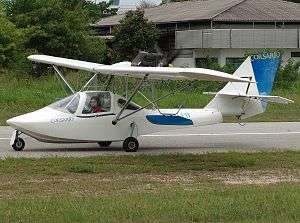Microleve Corsario
The Microleve Corsario (English: Corsair) is a Brazilian amphibious ultralight flying boat that was designed and produced by Microleve of Rio de Janeiro. The aircraft was supplied as a kit for amateur construction.[1][2][3]
| Corsario | |
|---|---|
 | |
| Role | Ultralight flying boat |
| National origin | Brazil |
| Manufacturer | Microleve |
| Introduction | 1988 |
| Status | Production completed |
| Unit cost |
€16,500 (Kit, 2011) |
The company appears to be out of business and the aircraft no longer available.
Design and development
The Corsario complies with the Fédération Aéronautique Internationale microlight rules. It features a strut-braced parasol wing, a two-seats-in-side-by-side configuration enclosed cockpit, retractable conventional landing gear and a single engine in pusher configuration. The landing gear is manually retracted.[1][2]
The aircraft fuselage and hull are made from composites. The Mark 5 version of the Corsario offered two alternative wings. An all-composite wing of 10.3 m (33.8 ft) span could be ordered with two 25 litres (5.5 imp gal; 6.6 US gal) fuel tanks fitted behind the seats in the fuselage or an aluminum tubing and aircraft fabric wing of similar span was available with two 35 litres (7.7 imp gal; 9.2 US gal) wing mounted fuel tanks. Standard engines available from the factory were the 64 hp (48 kW) Rotax 582 or 74 hp (55 kW) Rotax 618 two-strokes or the 80 hp (60 kW) Rotax 912UL four-stroke powerplant.[1][2][3]
Specifications (Corsario Mark 5, tube and fabric wings)
Data from Bayerl & Tacke[1][2]
General characteristics
- Crew: one
- Capacity: one passenger
- Wingspan: 10.3 m (33 ft 10 in)
- Empty weight: 247 kg (545 lb)
- Gross weight: 525 kg (1,157 lb)
- Fuel capacity: two 35 litres (7.7 imp gal; 9.2 US gal) wing mounted fuel tanks, a total of 70 litres (15 imp gal; 18 US gal)
- Powerplant: 1 × Rotax 912UL four cylinder, liquid and air-cooled, four stroke aircraft engine, 60 kW (80 hp)
- Propellers: 3-bladed composite
Performance
- Maximum speed: 160 km/h (99 mph, 86 kn)
- Cruise speed: 120 km/h (75 mph, 65 kn)
- Stall speed: 48 km/h (30 mph, 26 kn)
References
- Bayerl, Robby; Martin Berkemeier; et al: World Directory of Leisure Aviation 2011-12, page 65. WDLA UK, Lancaster UK, 2011. ISSN 1368-485X
- Tacke, Willi; Marino Boric; et al: World Directory of Light Aviation 2015-16, page 68. Flying Pages Europe SARL, 2015. ISSN 1368-485X
- Purdy, Don: AeroCrafter - Homebuilt Aircraft Sourcebook, Fifth Edition, page 206. BAI Communications, 15 July 1998. ISBN 0-9636409-4-1
External links
- Microleve website archives on Archive.org